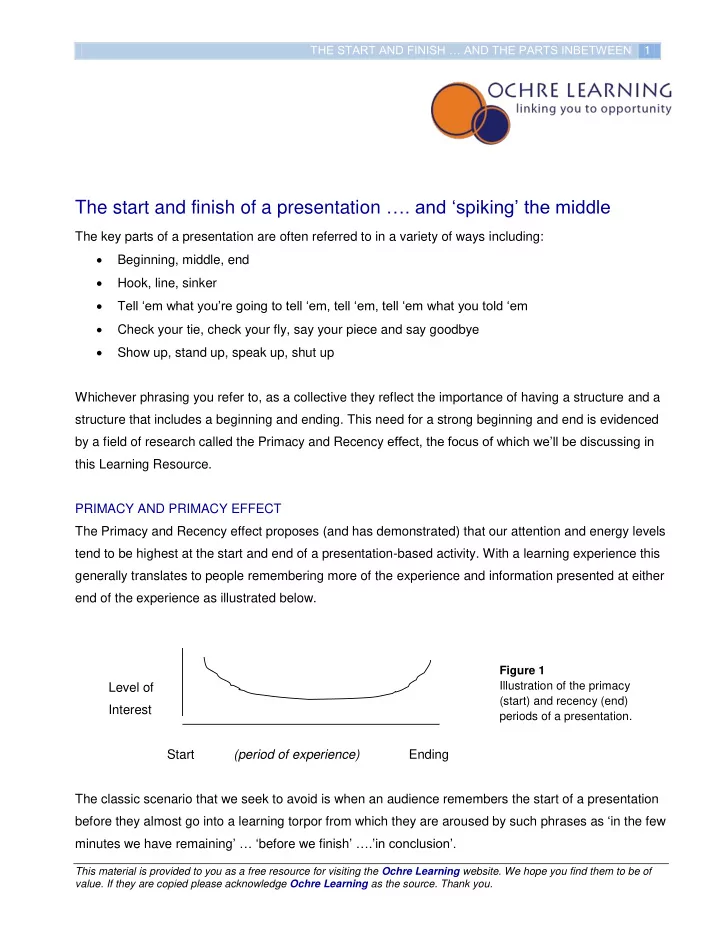

THE START AND FINISH … AND THE PARTS INBETWEEN 1 The start and finish of a presentation …. and ‘spiking’ the middle The key parts of a presentation are often referred to in a variety of ways including: Beginning, middle, end Hook, line, sinker Tell ‘em what you’re going to tell ‘em, tell ‘em, tell ‘em what you told ‘em Check your tie, check your fly, say your piece and say goodbye Show up, stand up, speak up, shut up Whichever phrasing you refer to, as a collective they reflect the importance of having a structure and a structure that includes a beginning and ending. This need for a strong beginning and end is evidenced by a field of research called the Primacy and Recency effect, the focus of which we’ll be discussing in this Learning Resource. PRIMACY AND PRIMACY EFFECT The Primacy and Recency effect proposes (and has demonstrated) that our attention and energy levels tend to be highest at the start and end of a presentation-based activity. With a learning experience this generally translates to people remembering more of the experience and information presented at either end of the experience as illustrated below. Figure 1 Illustration of the primacy Level of (start) and recency (end) Interest periods of a presentation. Start (period of experience) Ending The classic scenario that we seek to avoid is when an audience remembers the start of a presentation before they almost go into a learning torpor from which they are aroused by such phrases as ‘ in the few minutes we have remaining ’ … ‘ before we finish ’ ….’in conclusion’. This material is provided to you as a free resource for visiting the Ochre Learning website. We hope you find them to be of value. If they are copied please acknowledge Ochre Learning as the source. Thank you.
THE START AND FINISH … AND THE PARTS INBETWEEN 2 With deliberate and effective planning a learning experience can be deigned into several learning ‘blocks’ each with their own primacy and recency periods. The aim being to create an experience which reduces this period of learning torpor and thereby increases the overall potential for our audience to engage with our material. Such an experience can be represented with a series of spikes as represented by the following diagram: Figure 2 Level of Our aim with presentations is Interest to create as many periods as possible to engage our audience – as per the saying Start (period of experience) Ending ‘ variety = the spice of life ’. HOW DO WE CREATE THE SE ‘SPIKE’ PERIODS The first challenge is to ensure we have a strong beginning and ending. Think of movies and books and how they engage and enthral you from the start. A strong beginning is one that avoids “hi, my name is John and I’m here to talk about a field of research called the primacy and recency effect. I’ve been doing this f or quite a few years now and before this I …..” A start needs to engage and captivate, and communicate strong value for your audience. Most of the time there is no reason why the audience needs to know right up front information about you and what you ’ ve been up to in your life. So deliver them the value they want to hear to capture their attention, and then give some thought to providing information on yourself but keep it to those perspectives that are relevant to the presentation you are delivering … for example, if you need to demonstrate credibility and authenticity with respect to the subject area. Likewise with endings, they need to be strong. Often a presentation will finish with ‘does anyone have a quest ion’ which might work for those people who ask the question but for others who have no interest in the question it it can invite them back into that torpor we are trying to avoid. Better still to finish with a strong ending that recaps the key points and leaves with a strong message – at least this way if the This material is provided to you as a free resource for visiting the Ochre Learning website. We hope you find them to be of value. If they are copied please acknowledge Ochre Learning as the source. Thank you.
THE START AND FINISH … AND THE PARTS INBETWEEN 3 presentation does enter a period of Q&A with varying degrees of relevance for your audience, everyone is left with these concluding elements. Engagement strategies are an excellent resource when looking to create strong beginnings and endings. Engagement strategies are also an excellent resource when seeking to interrupt the pattern in Figure 1 so as to create increased levels of engagement throughout the experience (Figure 2) … i.e. create the spike periods. My belief is that a prolonged presentation using a single communication (engagement) strategy might work for some people but it will most likely lose the majority. And so our aim when designing and delivering presentations is to seek to ‘mix it up a little’ so as to maximise the opportunity for individuals members of your audience to engage through their preferred communication mode. We have provided more information on engagement strategies in the Learning Resource “ Engagement Strategies ”. This material is provided to you as a free resource for visiting the Ochre Learning website. We hope you find them to be of value. If they are copied please acknowledge Ochre Learning as the source. Thank you.
Recommend
More recommend